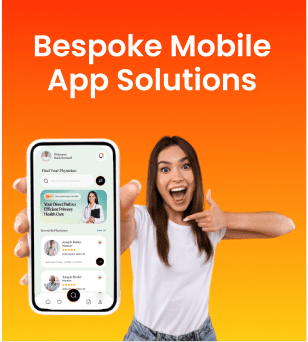The development process entails a meticulous approach that integrates cutting-edge technologies, user-centric design principles, and seamless functionality from conceptualization to launch.
Likewise, fitness application development requires a keen understanding of the factors contributing to the overall cost, including features, platforms, and resource allocation.
Trends in Fitness App Development:
Personalization:
In 2024, customization will still be very important when making exercise apps. Users want personalized workout plans, nutritional advice, and progress tracking that align with their goals and tastes.
Advanced algorithms look at information about the user, like their fitness level, health measures, and lifestyle choices, to make personalized suggestions for workouts, food, and changes to their lifestyle. Personalization keeps users interested and motivated by giving them relevant material and changing based on their changing needs over time.
Integration with Wearable Technology:
With so many people using fitness trackers and smartphones, users expect their devices and fitness apps to work together without problems. Wearable app developers design an interface that helps you track and analyze data in real-time, improving the whole user experience.
The heart rate, sleep habits, calories burnt, and exercise levels can all be tracked by fitness apps that use smart tech. This gives users useful information they can use to improve their health and workouts.
Moreover, synchronizing data across devices allows for comprehensive health tracking and goal setting, fostering a holistic approach to fitness management.
AI and Machine Learning:
Incorporating Artificial Intelligence (AI) and Machine Learning algorithms empowers fitness apps to offer personalized recommendations, predictive analysis, and adaptive training programs based on user behavior and performance data.
AI-driven coaching assistants provide real-time feedback during workouts, correct form errors, and suggest modifications to optimize performance and prevent injuries.
Machine learning algorithms analyze user data to identify patterns, predict future outcomes, and tailor recommendations for improved results. Moreover, AI-powered chatbots offer personalized guidance, answer user queries, and provide motivational support, enhancing user engagement and adherence to fitness goals.
Social Connectivity:
User involvement and inspiration increase when social features like community groups, leaderboards, and tasks increase. Cross-platform mobile app development solutions use social networking to build virtual groups where users can meet, share their exercise goals, and help each other.
Challenges and leaderboards make it fun to compete with others, push yourself to your limits, and share your successes with others. Joining group exercises, participating in virtual events, and collaborating with friends and influencers may all help users enhance their experience and feel more connected.
Steps in Fitness App Development:
Below are the steps guided by The App Founders to develop user-friendly applications:
Market Research:
It’s important to know the market, find holes, and figure out what users want before you start fitness application development:
Key Steps:
Competitor analysis: Look at other apps to see what makes them good or bad and what makes yours stand out.
Target audience: List your main users, what they like, and their health goals.
Trend analysis: To ensure your app stays useful, keep up with the latest exercise trends and technological advances.
User Experience and Design
A style that is easy to understand and use can make or break your app. Put user experience (UX) first to ensure smooth navigation and involvement.
Key Steps:
Wireframe: Draw a plan of how your app will be structured, laid out, and its main features.
Prototyping: Make a model of your app that can be clicked on to try and improve the user experience.
UI design: Pay attention to how the design looks and ensure it fits your brand.
Development:
At this stage, you turn your fitness application development idea into a product that works. Working with a reliable partner can have a big impact on the success of your app. So, choosing the right platform technology stack and hiring skilled app writers is important.
Key Steps:
Platform choice: Choose whether you want a native app (for iOS or Android) or a cross-platform option, like one built on Flutter.
Backend development: Make sure your app works well by setting up servers, databases, and APIs.
Frontend development: Concentrate on constructing the user interface.
Hiring app developers with experience: Expertise ensures the app library is built quickly, works well, and follows all the rules for its business.
Testing
Ensure your program is completely bug-free and easy to use before releasing it to the public.
Key Steps:
Testing functionality: Make sure everything works as it should.
Usability testing: Ask possible users for comments to make the UX better.
Test: Double-check the app’s responsiveness, stability, and speed in various environments.
Launching and Advertising
When your fitness application development is ready, you should share it with the world and try to get people to use it.
Key Steps:
App store optimization (ASO): Make your app’s title, description, and terms more relevant so that it shows up more often in app stores.
Marketing campaigns: To get people to download your app, use paid ads, social media, and relationships with influential people.
Feedback loop: After the start, keep getting feedback from users to make changes and improvements
Costs of Fitness App Development:
The cost of fitness application development varies depending on complexity, features, platforms, and development approach (in-house development vs. outsourcing).
The development cost can range from tens to hundreds of thousands of dollars, with ongoing maintenance and updates adding to the overall expenses.
The key cost components of fitness app development include:
1- Developing Costs:
The prices of development are the most important part of making a budget. This means hiring smart project managers, artists, and developers. Prices rely on area and level of knowledge.
For example, experienced coders charge more per hour. When figuring out these prices, you should consider how hard your app is to make and how long it takes.
2- Stack Cost of Technology:
It’s important to put money into the right technology mix. Many development tools are open source, but some software parts may have licensing fees.
If your app uses third-party APIs to process payments or track your health, you should also consider the costs that come with that.
3- Maintenance Costs:
After your fitness application development is released, it must be maintained regularly to stay up-to-date and safe. This includes fixing bugs, getting patches, and keeping the computer in good shape.
Set aside money for ongoing improvement. You must make changes based on user feedback and changing industry trends to stay competitive and meet user standards.
4- Advertising and Marketing:
Making a great app is only the beginning. To attract people, you need a good marketing plan. Spend money on digital marketing, App Store Optimization (ASO), and advertising events to get more people to know about your app. Talk to exercise gurus or clubs about working together to get more attention.
5- App Store Subscriptions:
Don’t forget the fees for distributing the app. The Apple App Store and the Google Play Store both take a cut of all app sales. Plan your finances as per the criteria.
Conclusion:
The journey of fitness app development begins with meticulous market research, guiding the identification of user needs and preferences, and culminates in a strategic launch accompanied by robust marketing efforts. Along the way, a focus on personalization, seamless integration with wearable technology, and harnessing the power of AI and machine learning is crucial in delivering a compelling user experience that drives engagement and retention.







